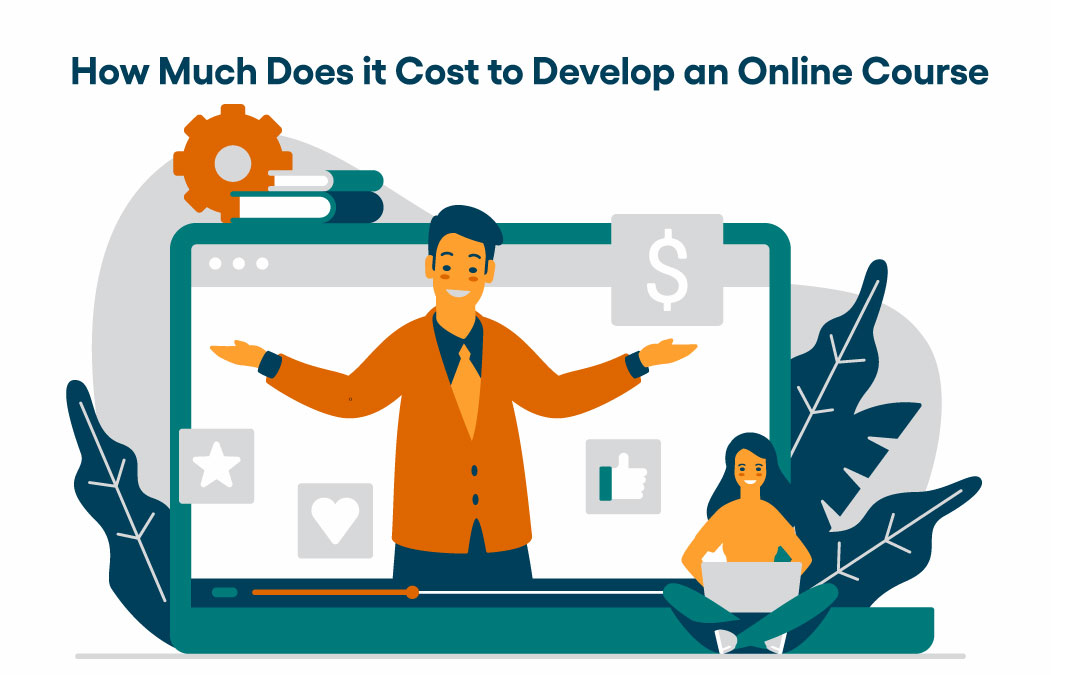Launching an online course in 2025? You can spend as little as a few hundred dollars or as much as tens of thousands depending on what you’re aiming to create. The price can vary widely—think basic video lectures versus elaborate interactive modules, live coaching, multiple instructors, and ongoing education. A lot depends on how detailed your content is, how long your course runs, the ways you choose to deliver it, and how many bells and whistles you want to add.
This guide is all about helping you get a handle on these costs and managing your budget wisely. With the right strategies, you can build courses that are not just rich in content and fun for students but also easy on your wallet. This way, you can make sure your courses are within reach for a broad audience.
Overview of Online Course Development Costs
The biggest costs in developing an online course usually come down to three main areas: creating the content, marketing it, and the extensive time and effort involved. A lot of this effort stems from the hard work of instructional designers and subject matter experts. These are the pros who take complex information and transform it into something that’s easy to grasp and truly engaging. Their expertise is essential for crafting content that really resonates and makes an impact.
Investing in top-notch visuals, interactive elements, and solid marketing might increase your initial costs, but these investments pay off by making your course more appealing and valuable. It’s all about striking the right balance: you want to invest enough to make your course stand out, but not so much that it strains your budget.
Kicking off a course development project the right way involves being clear about your objectives and understanding who your learners are. When you know exactly what your learners need, you can tailor your content to meet those needs directly. It’s also crucial to set clear, measurable goals and have a strategy for assessing how effective your course is.
Key Components of Online Course Development Costs
Developing an online course comes with several key components that directly affect both your budget and the overall quality of your course. These include crafting course materials, acquiring the necessary equipment and software, and choosing a Learning Management System (LMS).

Course Content Creation
At the heart of any online course development is the creation of the content itself. This usually involves teamwork between instructional designers and subject matter experts (SMEs). SMEs, who bring a wealth of knowledge to the table, typically charge between $42 and $63 per hour. Instructional designers, tasked with developing the curriculum and designing its flow, often earn around $38 per hour.
Adding complex content and various visual elements can bump up costs during the design phase. For more detailed projects, you might find yourself needing extra hands on deck. Including diverse content types like videos, workbooks and interactive templates can enrich your course but requires careful budget management during the planning and executive phases of your course.
Equipment and Software Needs
Investing in top-notch equipment and software is essential for crafting high-quality online courses. At the very least, you’ll need a reliable laptop and a steady internet connection. For superior audio quality, consider a good microphone, like the Blue Yeti, which costs about $70. For video, a budget-friendly option like the Logitech C310 webcam, starting at $37, might do the trick.
While these are one-time investments, they’re crucial for boosting the production quality of your course. You can also explore free software options for screen recording, such as Screencast-o-matic and PowerPoint. Hiring freelance videographers or camera operators can further elevate your video content, typically starting at $50 and $21 per hour, respectively.
Learning Management System (LMS)
Selecting the right Learning Management System (LMS) is vital for the success of your online course. An LMS does more than just deliver content—it also tracks learner progress, facilitates assessments, and can even issue completion certificates. Costs for LMS platforms can range from $100 to $2,000 per month, depending on the features offered and the number of licenses you need.
Advanced LMS features, particularly those that incorporate AI, can automate many administrative tasks, boost learner engagement, and enhance educational outcomes. Investing in a robust LMS can streamline your educational offerings and heighten learner satisfaction.

Marketing Your Online Course
Effective marketing is crucial for the success of your online course. Investing in strong marketing strategies can increase your course’s visibility and attract potential learners. Key strategies include SEO, paid advertisements, and social media marketing.
Email Marketing
Building an email list and utilizing top-notch email marketing tools are essential for promoting your course. Platforms like Kajabi offer comprehensive email marketing solutions, while more budget-conscious options like Mailchimp provide free services that are great for newcomers, supporting up to 500 subscribers. However, keep in mind that free tools might limit your promotional reach and capabilities.
Automating your email marketing can make your efforts more efficient and effective. Services like LearnWorlds employ AI assistants to help you craft engaging email content, fine-tuning your marketing approach.
Paid Advertising
Paid advertising is a potent tool for broadening your audience, though it requires a significant budget. You can start your advertising campaigns with an initial investment of around $1,000, with potential additional costs if you opt to hire freelancers or marketing agencies, which typically start at an extra $100 plus the ad spend.
When developing your course, it’s important to analyze what your competitors are offering and clearly highlight what makes your course unique.
Social Media and Content Marketing
Social media platforms like Facebook, Instagram, and LinkedIn are essential for connecting with potential students and promoting your course. Using content marketing strategies such as blog posts, infographics, and videos not only educates your audience but also enhances your course’s visibility.
The budget for social media and content marketing can vary widely depending on the platforms, tools, and tactics you select. Making effective use of these channels can boost interest and enrollments in your course, making them critical elements of your comprehensive marketing strategy.
Factors Influencing Course Pricing
Several factors affect how you price your online courses. These include the course’s length and complexity, market demand and target audience, and the pricing of competitive offerings. Understanding these elements is crucial for setting prices that not only cover your costs but also appeal to your target market.

Course Length and Complexity
The length and complexity of an online course impacts its cost and pricing. Courses that require extensive interactive elements and complex scenarios demand more time and resources to develop. This increased interactivity raises development costs and time as more expertise is needed to create engaging and effective learning experiences.
More straightforward, passive courses require less interaction, which makes them quicker and more cost-effective to create. Properly evaluating the time spent on recording, video editing, and creating marketing resources can help you establish realistic budgets and set appropriate prices.
Market Demand and Target Audience
Understanding the market demand and knowing your target audience are key to effectively pricing your online course. Being aware of your audience’s price sensitivity helps tailor your pricing strategy to their purchasing capacity. Accurately identifying your target audience also enables you to create content that resonates better, thus boosting enrollment and completion rates.
The overall market demand influences how you position your course in the marketplace. A deep understanding of potential learners’ needs and their willingness to invest in a course like yours informs your pricing strategy, ensuring your course is both competitively priced and attractive to your intended audience.
Competitor Pricing
Competitor pricing is a critical consideration when setting your course prices. Researching similar courses, their features, and their price points helps you understand where your course stands in comparison. This knowledge lets you assess the perceived value of your course against established benchmarks and ensure your pricing remains competitive.
Balancing the value your course offers with competitive pricing is key. Analyzing how competitors price their courses helps you strategically position your own in a crowded market. Sometimes, setting a higher price for your course may allow you to cover advertising costs and signal premium value to prospective students.
Tips for Managing Online Course Development Costs
Managing online course development costs requires strategic planning and resource management. Below are some strategies you can use to optimize your budget while maintaining quality to develop online courses.
Harness Free and Low-Cost Tools
Start by using free and low-cost tools to cut development expenses. There are many high-quality resources, such as video editing software and screen recording tools, available at no cost. These tools reduce your financial outlay and allow you to try out various content styles and formats. Integrating these free resources into your workflow helps you maintain high quality without breaking the bank.
Choose Between Outsourcing and In-House Development
Decide strategically between outsourcing and developing in-house. Outsourcing provides access to specialized skills and flexibility, but it can also lead to higher costs. Building an in-house team can be more economical and give you greater control over the project, though it requires more time and effort. Weigh the advantages and disadvantages to choose an option that fits your budget and goals.
Streamline the Development Process
Plan and prioritize tasks to streamline your development process. Focus your resources on the essential aspects of course development to avoid unnecessary expenses. Using all-in-one solutions and integrated tools can simplify your workflow, reduce the need for multiple platforms, and decrease overhead costs. By optimizing your development strategy, you can deliver your courses on time and within budget, ensuring a smooth and cost-effective production cycle.

Final Thoughts
Developing an online course encompasses a range of costs, including content creation, equipment, marketing, and quality assurance. It’s essential to grasp how each component affects your budget to craft a course that’s both successful and financially sound. By managing these costs strategically, you can maximize your investment and provide a top-notch learning experience.
Frequently Asked Questions
What is the typical budget range for developing an online course in 2025?
The typical budget range for developing an online course in 2025 is between $5,000 and $150,000, influenced by factors like complexity and length. Establishing a clear scope early on can help manage costs.
How much does it cost to hire an instructional designer?
Hiring an instructional designer typically costs around $38 per hour, with freelance rates starting at approximately $60 per hour. This investment can enhance the effectiveness of your educational materials.
What are the equipment and software needs for creating an online course?
To create an online course, equipment includes a laptop, a reliable internet connection, a quality microphone like the Blue Yeti, and a webcam such as the Logitech C310.
Why is marketing important for online course success?
Marketing is vital for online course success as it enhances visibility and attracts potential learners. Implementing strategies like SEO, paid ads, and social media marketing can boost enrollment.
How can I manage online course development costs effectively?
To manage online course development costs effectively, utilize free and low-cost tools, and carefully decide between outsourcing and in-house development. Streamlining the development process will also help maintain quality while keeping expenses in check.
Spotlightr Video Hosting For Your Course
Discover why Spotlightr is the #1 choice for course creators and e-learning professionals.
Register for a free 2 week trial, no credit card required.

